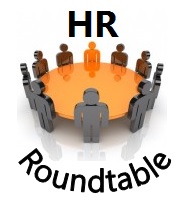How do you view employees? We rarely talk about this in public forums or meetings, but we have no problem giving people our opinion in the hallway!! We wanted to stem the tide of side conversations at the March HR Roundtable (of Cincinnati) and took on the topi c “Employee relations, and how to do it well.” To get the small groups started we began with these three teaser questions:
c “Employee relations, and how to do it well.” To get the small groups started we began with these three teaser questions:
- How does management view employees in general?
- When/how do we interact with employees most often?
- How can we coexist better?
Fortunately, we had another full house of attendees, so they were eager to dive in. Once we reconvened, they had some very solid insights which they shared. Take a look . . .
How does management view employees in general?
- As subordinates (or those below me) — Arrrrgh!! How sad is this? When we think of “employees” only as people who exist below whatever ladder rung we occupy in the organization. When people have this mindset, you can’t help but have an Us vs. Them culture. Good luck with that.
- Short-term results generators — This was such a cool, offbeat answer that I had to include it. Employees are people who work with companies more on a short-term basis than they generally had in the past. The landscape has changed because companies are the ones who set this table. Once they treated people as short-term, employees agreed and didn’t look at having a career with a company. They changed to people who occupied a job. This is not a negative. This is the reality for all of us – employees and orgs.
- Chess pieces (pawns) — This is even more dire than viewing people as subordinates. However, there was a palpable response from the attendees with this answer. When people feel they are mindlessly interchangeable for someone else’s purposes, it’s not hard to see how people view themselves this narrowly.
- Our most important investment — It was great to see the tide turn in the Roundtable when people started listing the positive attributes of employees. If you see people as the “most important” investment a company can make, you can guarantee those employees feel valued and engaged.
- Empowered — Another great answer that is still a bit aspirational in most companies. We proclaim we want, and believe in, empowerment as long as it fits our structures. Organizations need to provide a playing field for employees to perform and quit thinking that empowerment is occurring if the environment is really more about constrain and control. Empowerment can exist if the leadership fosters this approach and allows for divergent approaches and ways to do work.
- Problem solvers and innovators — This answer rocked because this is a bit more tangible than only wishing people were autonomous. When you view, and allow your people to be performers, then they will solve problems and be innovative. Employees want to inherently do good work. The challenge isn’t the willingness of people; it’s the culture and environment that is provided for them to do their work.
When/how do we interact with employees most often?
- When there’s a problem — We want to gloss this over, but most interactions between employees involve a problem. It may be a work problem that brings people together to be evaluated and solved. Or, it may be that we interact with each other when we have a problem between each other. Having challenges to work on is healthy and why organizations exist. The other side is not healthy. It leads to the next answer . . .
- Only when we “have to” — This is harsh, but again, a reality. This is especially true between managers and their direct reports. Interactions seem more forced or task oriented only. We want to skip the personal/relationship side of people because we think that this is just a waste of time when we should be focused on the work at hand.
- When it’s easy — Many of the social conversations that happen between employees at work are 10 miles wide and a quarter inch deep. It almost doesn’t even scratch through the surface of the depth that is in each person. However, it’s safe, and we’re eager to share thoughts on sports, popular culture and possibly kids/pet stories. These are important to have even though they lack much long-lasting connection. We want to be friendly with each other and this level of communication allows for that to happen.
- During forced times – meetings and/or performance evaluations — Organizational culture forces employee interaction in these types of forums. There are books about the effectiveness of meetings and performance reviews. They both can be done very well. However, most employees complain about their current ineffectiveness more than they do their value. Since these forums exist in companies, it would be worth your time to invest and see how to make them both worth people’s time and effort vs. just having them because you’re “supposed” to.
- We talk to who we like and avoid who we don’t — This is just fun to have in an HR blog summary!! Organizations, and HR, would be better to understand that people are going to hang out with the folks they like much more than those they don’t. There should never be any room for anything that is discriminatory – ever. People are going to gravitate to those they relate to because of their role, their level in the organization or if they share in common work. Allow this to occur naturally. Leaders and HR need to rise above this and work/interact with all employees. We’ll cover this in the next section.
- When we train — This was a solid observation because we often look at the class or the material of training and miss the human interaction. Try to be more attentive to the interaction between employees during training, and be more intentional in having this as a facet of the training you offer. People learn more when they learn from each other instead of a lecturer at the head of the class.
How can we coexist better?
- Change language to “we” — Organizations need to evaluate if an Us/Them situation exists, and stomp it out. All employees are stronger performers when there isn’t a segmentation of people and they’re moving in generally the same direction. The ability for companies to have a “we” approach also shows a healthy leadership and HR effort. Strive for this and eliminate the camps.
- Be active listeners — Employee relations will always be handled more consistently when HR takes the time to listen first, listen second, and then listen again. We need to work on fighting the urge to jump to a solution five words into a conversation. If your employees are the best investment you can make, then listening has to be the bedrock that begins this investment. No exceptions.
- Don’t allow interactions only during formal settings — One of our attendees, Jerry Wagner, had the best quote of the day: “A review is a negotiated lie.” There was literal applause at this comment because it captures how most people feel — managers and employees — when they are forced to interact. If you feel you must have reviews, then really dig in to make sure they are conversations that occur regularly over time and not just one hour set aside once a year.
- Visibility without restrictions — Be in the midst of your employees because it’s a day that ends in “y.” Quit having the approach of seeing people with an agenda item. Also, managers, quit making people feel like they need a hall pass to visit with each other. Human interaction is not a waste of time. People want to be connected and engaged to each other. Let them do it and quit being hall monitors.
- Examine how you can flourish instead of coexist — This was a phenomenal final answer of the day. Instead of looking at how to tolerate each other, see how employees can thrive together!! The key to this happening is for ALL people to remember they’re employees – from the CEO to the person on the frontline. We’re in this together and not in spite of each other.
This Roundtable flat rocked!! It was great to see everyone take interest and discuss employee relations from a well-rounded perspective.
